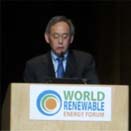DOE Secretary sees bright future for solar
 Yesterday Department of Energy (DOE) Secretary Dr. Steven Chu discussed why he got involved in renewable energy and how solar and wind are becoming cost competitive with natural gas—which is currently cheaper than coal in the U.S. He also warned of the U.S. losing ground in terms of manufacturing jobs, unless Congress takes action to continue to support renewable energy. Chu made his remarks at Wednesday’s World Renewable Energy Forum keynote address.
Yesterday Department of Energy (DOE) Secretary Dr. Steven Chu discussed why he got involved in renewable energy and how solar and wind are becoming cost competitive with natural gas—which is currently cheaper than coal in the U.S. He also warned of the U.S. losing ground in terms of manufacturing jobs, unless Congress takes action to continue to support renewable energy. Chu made his remarks at Wednesday’s World Renewable Energy Forum keynote address.
Chu, a noble-prize winning physicist, first became interested in energy as he became more concerned about climate change. “I became increasingly convinced that there were real risks,” he said. He cited research showing that despite some uncertainties humanity has had an impact on climate change. “This is to tell you that there are a lot of unknowns, but the risks and the potential for risks are very real.” Risk that the planet already is seeing include increased violent storms and international warming, which has occured over the past century.
“The good news is we can do something about it” Chu said. “And the cost of doing something about it is going down with each passing year.”
Already the levelized cost of electricity is starting to compete with other energy sources in markets where prices are high. Places like Hawaii, where prices range around 26 cents per kilowatt hour for residents.
In markets around world, including Italy and Spain, the levelized cost of solar power is lower than other forms of electric generation and it’s now cheaper in Australia as well. “By 2013 Brazil will slip in and California is on the cusp,” Chu said. “this is residential,” he added. California’s commercial market already is already less than 15 cents a kilowatt hour, he said.
While that’s great, the solar manufacturing industry is still challenged by increased international competition.
“In 2010 there was a prediction that by the time we get to 2013, the cost of silicon would be…at about a $1.00 a watt,” Chu said. “What actually happened was that by January 2012 the spot market price is 93 cents a watt. Right now it's 86 cents a watt and in the last big ‘China's coming for us,’ Chinese solar deployment it was 72 cents a watt. This is very scary if you're in the solar market as a matter of a fact,” he said.
At this point, the industry may slow its spiral to cheap. “The hope is that this will flatten out for a year but it will continue to go down because the technology is continuing is improving very rapidly,” Chu said. For the U.S. to stay competitive in the industry Chu supported extensions of the Investment Tax Credit, Production Tax Credit and the Advanced Energy Manufacturing Tax Credit.



